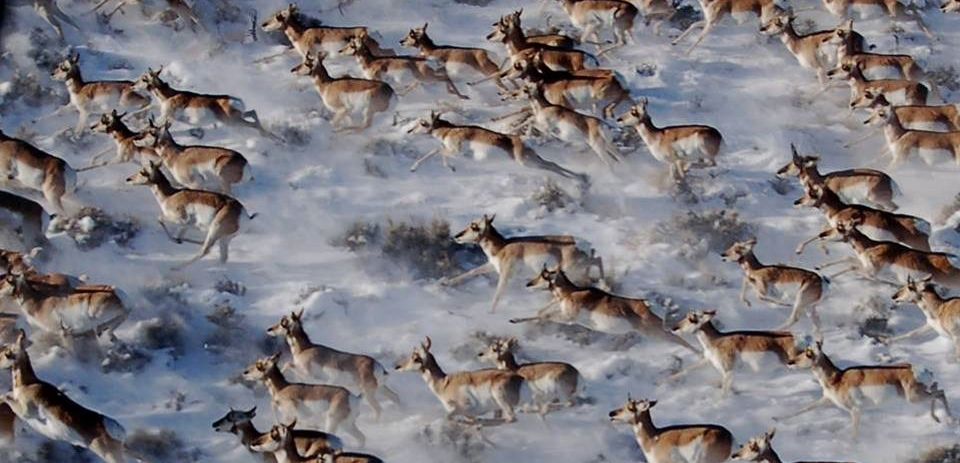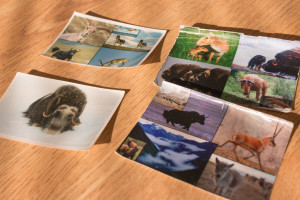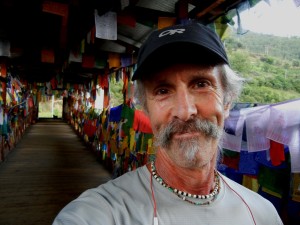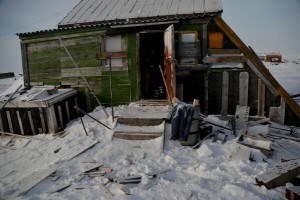
Pronghorn migrate the longest distances of any new world land mammal except for caribou. Photo courtesy of Joel Berger.
Like many parents, Joel Berger has a photo of his daughter in his wallet. Next to that are photos of the animals that he has been researching over the years, including saiga — a kind of antelope — muskox, wild yak, rhino and takin, a member of the camel family.
Why carry the animal photos? As he explained it, when he’s on an airplane, he inevitably is asked what he does for a living. “I usually say ‘biology’ and the conversation ends,” Berger said. But sometimes, the passenger next to him will probe for more details. He tells them that he works with wildlife and “cool” species from far away.

“Some of the species they’ve never heard of,” he said — then he uses the photos to supplement his explanation, taking the opportunity to educate the public. “I try to be a voice for these species that are unknown.”
And, indeed, Berger’s been and continues to be a voice for these animals, the ones that live in places he describes as “uncrowded playing fields.”
Berger was nominated this month for the Indianapolis Prize, an internationally recognized gift award for researchers whose achievements will likely lead to long-term sustainability. As a finalist for the prize for a second time, he joins five other conservationists described as “heroes saving species.” The prize will be awarded next fall.
Rocking the boat, in the name of conservation
Berger was kicked out of Namibia in the early 1990s after the government did not agree with his research — which they had approved— on ways to stop poaching of black rhinos. Officials there had decided that removing rhino horns would decrease poaching: no horn, no incentive. However, Berger’s team found that without their horns the animals would be left defenseless and more prone to being killed by predators.

“Why do you invite researchers in? They wanted the results to support their policy,” he explained. The Namibian action also put a freeze on Berger’s research and personal funds. It eventually took a high-level U.S. official — Vice President Al Gore, to be exact — to intervene and remove the hold on his finances.
Berger’s research has not always risen to that level of controversy. But the fact that he focuses on lesser-known species excites him, and it helps to enlighten the masses. Berger said he likes to focus on iconic species because they seem to have more relevance to people. Think about bison and moose and pronghorn in the West, for example.
His muskoxen and yak research now have implications for climate change and recession of the icecaps, too.
Berger is set to leave within the week for Wrangel Island in the Arctic Ocean, north of Siberia. “We’ve documented polar bears eating muskox,” he explained. “We don’t know if it’s just now happening or if people didn’t know it’s been happening because they’re not out there in winter observing it.”

For this research expedition, Berger will experiment with models — including donning a polar bear suit — to approach the muskox and document the behavior. He’s used this technique before and will compare it with similar research he’s working on in Alaska, where grizzly bears are preying on muskox. (Yes, Berger also has grizzly bear and caribou suits, all in the name of research.)
Temperatures on Wrangel Island usually stay well below zero, and wind speeds reach up to 90 mph. “It’s not really a fun place at times,” Berger admitted.
How to ‘do’ conservation in the real world
Working in this and other remote locations, Berger must also be a diplomat; he works closely with Russian research counterparts and the government. That’s something that he likes to relay to students, especially those who pursue a career in wildlife biology or conservation merely because they want to work with animals (rather than people).
“I’ll go to a country for a couple of months and I’ll meet with four audiences,” Berger explained. “I’ll go to the government, usually the capitol, and I’ll ask what they think needs to be done. I’ll go to local universities, a non-governmental organization and then I’ll go out into the field and talk with local people.”
Armed with at least these four perspectives, Berger said he can then figure out what needs to be done. “When I talk with students and the public, I let them know it’s not just about the science, and that you have to go beyond the science,” he said.
Berger came to Colorado State University last August, and he’s settling in to his teaching schedule. He’s also served as a guest lecturer this semester, while he’s not teaching.
In a recent undergraduate class lecture, in which he talked about saiga in Mongolia and pronghorn in Wyoming, he said that he shared data but also made it entertaining. “Only one student fell asleep out of 80,” he said, with a smile. “I want people to learn and to get inspired.”
Berger said he likes to educate young people on how to conceptualize conservation science and also to show the challenges — and departures from what is taught in textbooks — that exist in the real world.
“I worked with a convicted felon who is a rhino poacher for three years,” he said. “I bring these stories in, to help students understand how you do conservation in the real world.”
Joel Berger is the Barbara Cox Anthony University Chair in Wildlife Conservation in the Warner College of Natural Resources. He is also a senior scientist with the Wildlife Conservation Society.
He has written five books, including two with an American West flavor: The Better to Eat You With: Fear in the Animal World and Bison: Mating and Conservation in Small Populations.
The team behind the Indianapolis Prize produced a video, highlighting Berger’s preparation for a trip to Wrangel Island.
Animals in Joel Berger’s wallet
Muskox: Once extinct in Beringia, a region in the Bering Strait that includes coastal areas of Russia’s very wild east and Alaska; reintroduced in Alaska in the 1930s; 20 animals sent to Wrangel Island in the Asian Arctic in 1975
Saiga: More than half of entire species — at least 211,000 — died suddenly in May 2015; researchers including Berger believe it was due to bacteria in the soil
Black Rhino: Critically endangered; at start of 20th century, half a million animals in the wild; in the 1970s population dropped from 60,000 to 4,000; deaths in Africa may soon outpace births
Takin: Bhutan’s national mammal since 1983, this giant forest mix of goat and sheep is preyed on by tigers at low elevation and snow leopards up high; presence is spotty from northwest Burma and southern China into India and Bhutan